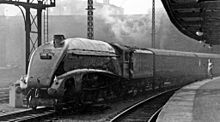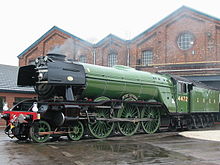Flying Scotsman (train)
The Flying Scotsman (in German: Fliegender Schotte ) is a pair of trains from London Kings Cross via York and Newcastle to Edinburgh Waverley and back via the East Coast Main Line (ECML). Both trains left the stations in Edinburgh and London at 10 a.m. from 1862 to 2011 . Since 2011, the train has only operated in the direction of London and starts in Edinburgh at 5:40 a.m. The Flying Scotsman is the fastest connection between the two cities.
The Flying Scotsman is not to be confused with another train with a similar name, the Royal Scotsman . The latter is a luxury train that runs exclusively from Edinburgh Waverley Station , from where it runs through the Highlands on a circular route between April and October .
Routing
The Flying Scotsman operates the East Coast Main Line . The connection arose from the routes of three railway companies. The section from London to Doncaster originally belonged to the Great Northern Railway . The North Eastern Railway built the section from Doncaster to Berwick , the section in Scotland belonged to the North British Railway . Thanks to improvements to the infrastructure, travel times have been continuously reduced. The current route in the area of the North Eastern Railway was opened in 1877, a year later the terminus in York was replaced by a through station. In 1906, a second bridge was opened over the Tyne in Newcastle , eliminating the need to push the trains back into the terminus there. In the years after the Second World War , the tracks were extensively renewed until 1977. In 1983 the line near Selby was relocated to bypass a mining area. The East Coast Main Line was electrified by 1991.
Special Scotch Express
In 1862 the Special Scotch Express ran for the first time . The trains ran at 10 am in London and Edinburgh from. The journey lasted ten and a half hours, including a half-hour stay in York. The train carried through cars from London to Sheffield and Manchester . The train was soon popularly known as the "Flying Scotsman", which was officially used after a few years.
The trains were initially reserved for first and second class passengers; it was not until 1888 that the train could be used with third class tickets. During this time, several railway companies offered trains between London and Edinburgh. In the tough competition, these companies tried to drive faster than their rivals. After several accidents, the companies agreed in 1888 on a travel time of eight hours and 15 minutes for all trains. In the following years, the journey time remained the same, despite the shortening of the stay in York to 15 minutes, the focus was rather on travel comfort. Together procured through cars replaced the compartment car of the individual companies, the cars were equipped with toilets and heating and lighting improved. From 1900, the companies involved started using dining cars .
Flying Scotsman
In 1923, many previously independent railway companies were merged. The three companies over whose network the Flying Scotsman operated, went into the London and North Eastern Railway (LNER). LNER introduced new cars and started a successful advertising campaign. From 1928 the pair of trains traveled between the two cities without stopping. In order to avoid intermediate stops, troughs were placed between the rails to absorb water during the journey, from which scoop pipes could fill the tender. The locomotive personnel could be exchanged through a corridor in the tender. The locomotives used at that time belonged to the LNER class A3 . The 4472 locomotive of this class was named "Flying Scotsman" like the train, it is the only example that has been preserved and has been operational again since the beginning of 2016. Despite the non-stop traffic, the travel time remained at eight hours and 15 minutes. That only changed in 1932 when, after the global economic crisis, the increasing number of individual and domestic air traffic forced LNER to continuously cut travel times. By 1937 the travel time could be reduced to seven hours and 20 minutes. The trains now had a bar, a hairdressing salon and a first-class train restaurant, and from 1938 the fleet of cars was air-conditioned. With the outbreak of World War II, travel times were again stretched to eight hours and 15 minutes and only simple meals were offered.
The war led to an explosion in passenger numbers. At times the trains carried up to 20 cars and despite the addition of a second pair of trains, the trains were constantly overcrowded. After the end of the war, the situation returned to normal. On October 26, 1947, the train was involved in a serious railway accident when it derailed at Goswick station . 28 people died.
British Rail , which was created in 1948 through the nationalization of the large private railways, succeeded in reducing travel time to seven hours despite the abandonment of non-stop traffic. From 1949 the Flying Scotsman again served intermediate stops, as a non-stop train the Capitals Limited was used in parallel , which was called Elizabethan from 1953, the coronation year of Elizabeth II . The LNER class A4 streamlined locomotives hauled the train until the early 1960s . With the introduction of the diesel-electric "Deltic" locomotives , travel times were reduced by one hour in 1962.
From 1967 new air-conditioned cars were used. In 1977 the journey time was only 5 hours 50 minutes. Just one year later, the Flying Scotsman was driven with new high-speed multiple units of the type HST 125 (Class 43), which only need four hours and 35 minutes. In 1991 the diesel multiple units were replaced by completely overhauled electric high-speed trains of the type HST 225 (class 91 locomotives with nine type Mark 4 passenger cars and a control car). From 2019 it is planned to launch new multiple units from the manufacturer Hitachi Ltd. developed as part of the Intercity Express program . to use.
From 1994, the year British Rail was privatized, until 2007, the Flying Scotsman was operated by the Great North Eastern Railway (GNER). The 623 kilometer journey lasted four hours and twelve minutes in 2004. Today (2009) the travel times are slightly longer at four and a half hours. Since December 2007 the Flying Scotsman has been operated by the National Express East Coast (NXEC), as have the trains The Hull Executive (Hull – London), The Northern Lights (London – Aberdeen) and The Highland Chieftain (London – Inverness) who were also part of the InterCity East Coast rail franchise. On November 14, 2009, the operation of the Flying Scotsman, as well as the entire long-distance service of the ECML, was taken over by the state rail operator East Coast after National Express returned the franchise due to profitability problems. East Coast reduced the Flying Scotsman in 2011 to a particularly fast morning train from Edinburgh to London, only with an intermediate stop in Newcastle and without a corresponding return train. Today (2019) the travel time is exactly 4 hours. Following a reassignment, Virgin Trains took over operations on the ECML from March 2015, including the Flying Scotsman .
Web links
Individual evidence
- ↑ a b c d Fritz Stöckl: European railway trains with sonorous names . Carl Röhrig Verlag, Darmstadt 1958, p. 71
- ↑ 93 year old locomotive: "Flying Scotsman" is steaming again. Spiegel Online, January 8, 2016, accessed May 15, 2016
- ↑ Chris Milner: Stagecoach / Virgin bid wins East Coast franchise The Railway Magazine, November 27, 2014 ( Memento of the original from May 15, 2016 in the Internet Archive ) Info: The archive link was inserted automatically and has not yet been checked. Please check the original and archive link according to the instructions and then remove this notice. , accessed on May 15, 2016


